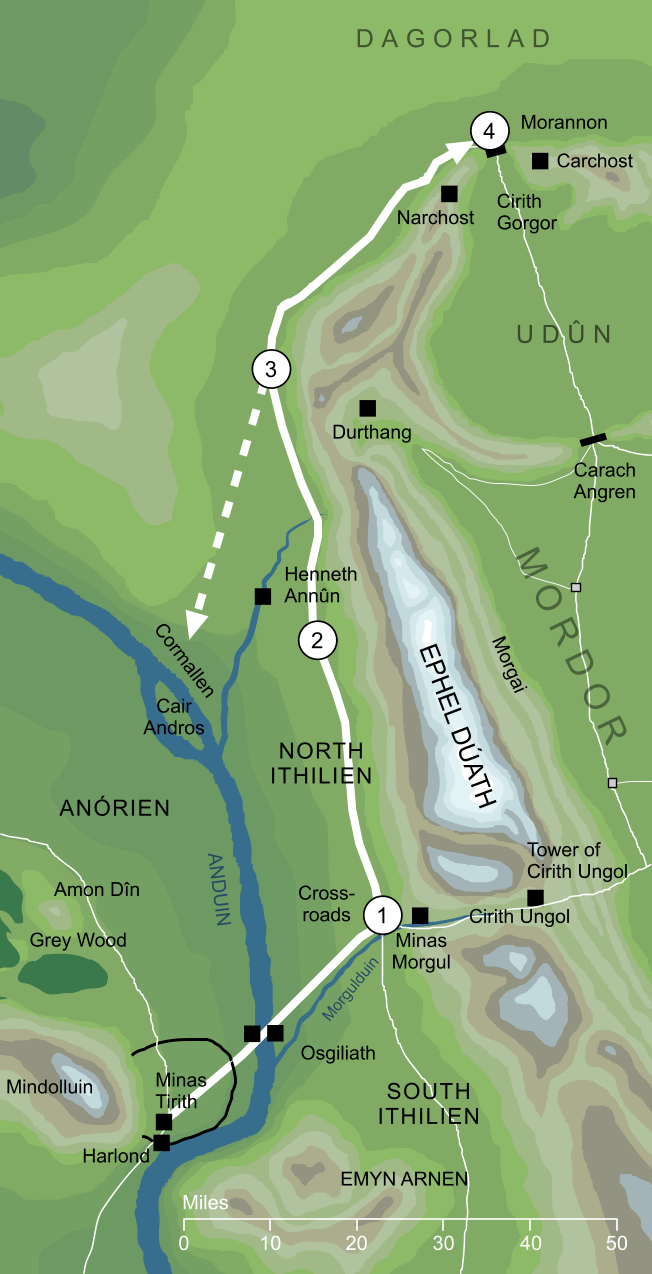
The journey of the Lords of the West from Minas Tirith to the Gates of Mordor. (Note that some of the locations shown are necessarily approximate.)
(1) At the Cross-roads they restore the broken statue there and divert briefly to break the bridge of Minas Morgul. When they depart, they leave a guard of Men behind to watch for enemies from the south.
(2) At a cutting in North Ithilien they detect and avoid an ambush, slaying or driving off a small force of Orcs and Easterlings. From this point in the journey, they are watched from the skies by the Nazgûl.
(3) At the edge of the Desolation of the Morannon, Aragorn sends away those overcome by fear to instead recapture and guard the island of Cair Andros.
(4) The Lords of the West reach the Morannon after a journey of eight days.
The journey of the Lords of the West from Minas Tirith to the Gates of Mordor. (Note that some of the locations shown are necessarily approximate.)
(1) At the Cross-roads they restore the broken statue there and divert briefly to break the bridge of Minas Morgul. When they depart, they leave a guard of Men behind to watch for enemies from the south.
(2) At a cutting in North Ithilien they detect and avoid an ambush, slaying or driving off a small force of Orcs and Easterlings. From this point in the journey, they are watched from the skies by the Nazgûl.
(3) At the edge of the Desolation of the Morannon, Aragorn sends away those overcome by fear to instead recapture and guard the island of Cair Andros.
(4) The Lords of the West reach the Morannon after a journey of eight days.
Those lords and kings who accompanied Aragorn on the hopeless march from Minas Tirith to the Black Gate of Mordor in the closing days of the War of the Ring. As well as Aragorn himself, the Lords included Gandalf, Imrahil of Dol Amroth and Éomer of Rohan. They had no real hope of overcoming the forces of Sauron, but rather sought to distract his Eye and allow Frodo the Ring-bearer to achieve the Quest of Mount Doom and cast the Ring into the Fire. In this they succeeded: Sauron was defeated, and an Eagle flew to Minas Tirith bearing tidings of the victory of the Lords of the West over the Dark Lord.
It should be noted that this is a very unusual use of the title 'Lords of the West'. In almost all cases, this is a title of the Valar, the Lords of Valinor in the West of the World. In this unique case, however, the title is evidently applied to the lords of the Westlands of Middle-earth who confronted the Dark Lord.
Historically, when the Númenórean King Ar-Adûnakhôr claimed the title 'Lord of the West', this was considered to be nothing short of blasphemy against the Valar. The fact that Aragorn and his companions are so described without any such reservation is therefore remarkable, and perhaps shows how highly their achievement was esteemed.
Notes
1 |
For some of the leaders of the army that marched from Minas Tirith, it is perfectly clear whether they counted as one of the Lords or not. King Aragorn Elessar obviously qualified, as did King Éomer and Prince Imrahil, and doubtless Gandalf (and perhaps also lords of the provinces of Gondor). For other members of the host, their status is less clear. Legolas led no Elves to the Black Gate, but he was nonetheless a prince among his own people, and might be considered one the Lords. For others such as Gimli or Peregrin Took, or the Sons of Elrond, the case is less clear. Important as their roles had been in the War of the Ring, they were neither nobles nor leaders, and whether they could be considered as Lords of the West is open to question.
|
Indexes:
About this entry:
- Updated 10 June 2023
- This entry is complete
For acknowledgements and references, see the Disclaimer & Bibliography page.
Original content © copyright Mark Fisher 2020, 2023. All rights reserved. For conditions of reuse, see the Site FAQ.

